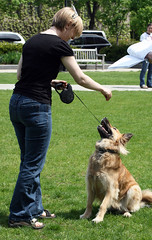 Isn’t using treats to train your dog just bribing them? Are you setting yourself up for failure in the future when you don’t have a treat in your pocket?
Isn’t using treats to train your dog just bribing them? Are you setting yourself up for failure in the future when you don’t have a treat in your pocket?
If used improperly, treats can become bribes and you can set yourself to have a dog that will ‘only work for treats’. This isn’t the optimal behavior we’re looking for with obedience training. There’s a trick to using treats in training!
Treats can become bribes because most novice trainers don’t understand the basics of positive reinforcement training. You are only using treats to start the process. If a behavior is offered and something good happens to the dog (like a tasty snack), the behavior is more likely to be repeated in the future. Positive reinforcement training is more like slowly molding your dog’s behavior. You start out using treats because they are a high value reward, especially for food motivated dogs.
The first trick is to use treats generously when you’re first teaching a command, but more sporadically once the desired behavior has been learned. Once your dog knows what the ‘sit’ command is asking for, try substituting praise for the treat every other time, then every 3, very gradually phasing out the treats. Be sure to be generous with praise or play with a favorite toy as a reward to reinforce the desired behavior.
Next, you should try to hide the treats from view before delivering a command. Don’t show a treat then hide it in your fist. Put prepared treats in a treat pouch or a pocket out of your dog’s sight, only presenting a tidbit once the behavior has been offered. This doesn’t usually work for my dogs; they can sniff them out in my pocket pretty readily. If it’s the same in your case, ignore the sniffing and drooling until they seem to “forget” that you have something in your pocket.
 There are occasions in teaching a new behavior when you may have to use treats for molding the first few times (e.g. holding a treat in your hand and raising it above the puppy’s head until they “sit”), but this practice should cease once the connection is made in your dog’s brain that the word “sit” (accompanied with a hand signal) means to put their behind on the ground. Some trainers recommend that you give a different treat other than the lure as the ‘praise’ instead of the lure itself.
There are occasions in teaching a new behavior when you may have to use treats for molding the first few times (e.g. holding a treat in your hand and raising it above the puppy’s head until they “sit”), but this practice should cease once the connection is made in your dog’s brain that the word “sit” (accompanied with a hand signal) means to put their behind on the ground. Some trainers recommend that you give a different treat other than the lure as the ‘praise’ instead of the lure itself.
When your dog has mastered a move in your home and you have mostly phased out the treats, it is time to move the training to a new locale. A good place to start is your own backyard to minimize distractions. When you move to a new location, there are new distractions, smells, and sounds to tempt your dog away. You may need to start out again using high value treats to set yourself up for the most success.
For more information on positive reinforcement training techniques see “The “Sit Sit Sit” Phenomenon”and “Tips for Trouble-Free Training”
 That Pet Blog That Pet Place Pet Blog
That Pet Blog That Pet Place Pet Blog
